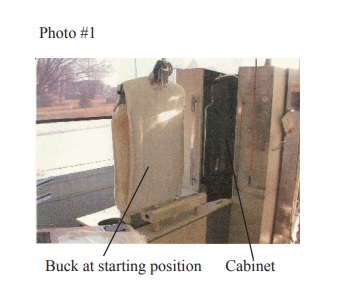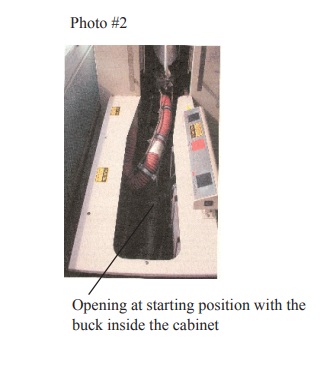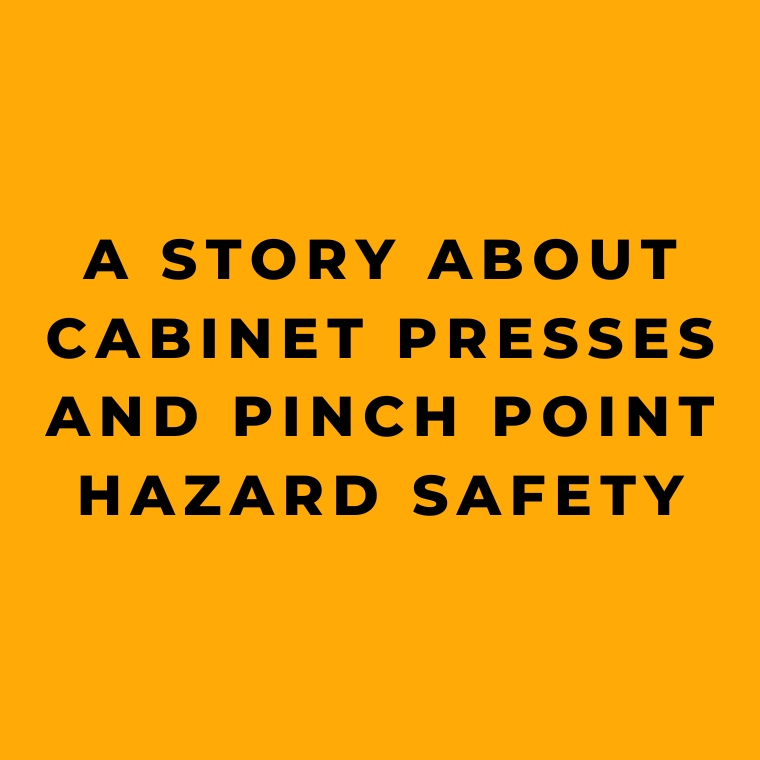The objective of this article is threefold:
- To raise awareness of the pinch point hazard associated with certain semiautomatic shirt pressing “cabinet presses”;
- To encourage all laundry employers who utilize shirt pressing “cabinet presses” to examine their equipment for the presence of such a pinch point hazard; and
- To offer information to employers that will enable them to address this hazard effectively.
The Story
Let me tell you about a story involving a mishap that happened with one of those semi-automatic shirt-pressing cabinet presses:

Now, this contraption is made to press the body of a dress shirt real nice-like. It’s got a mannequin, or what they call a “buck,” that you put the shirt on at the loading table, and a cabinet that houses the press heads. All the operator has to do is press and hold the two transfer buttons and a foot pedal at the same time, and the buck gets moved on into the cabinet. Once it’s in there, the two halves of the press close up for a 26-second timed cycle. When that’s all done, the press opens back up and the buck heads on back to the dressing table.
Now this cabinet press has a cancel button too, so if you push it, it’ll stop the press cycle and bring the buck back to the dressing spot. It’s also got safety bars on both sides of the cabinet entrance that work like cancel buttons, stopping the press from doing its thing. These safety bars make sure the operator doesn’t get caught by the buck as it goes into the cabinet. But here’s the kicker: the machine’s controls don’t have a way to stop the buck from coming out of the press automatically during or after the press cycle.
This creates a pinch point hazard between the buck and the end of that 10-inch by 48-inch opening (photo #2) at the dressing position:

Accident Investigation
When the investigators looked into the accident, they found that when the buck goes into the cabinet press, it leaves a 10-inch wide by 48-inch long opening in the loading table (or dressing table) at the starting position. When the operator pushes the transfer controls, the press starts an automatic cycle. At the end of the cycle, the buck comes back to where it started on the loading table. But this press doesn’t have a cancel or emergency stop button to stop the buck from moving as it comes back to its starting position on the loading table.
The accident happened when the operator dressed the buck and got the press cycle going. For reasons we can’t quite figure, the operator put her head, upper body, and right arm into that 10-inch by 48-inch opening in the dressing table. And, sad to say, she was fatally crushed between the buck and the frame of the machine when the buck automatically returned to the starting position at the dressing table after the pressing cycle finished.
Additional Information
The American National Standards Institute (ANSI) has established a standard for commercial laundry and dry-cleaning operations, ANSI Z 8.1-1996. Paragraph 4.4.2.2 of Z 8.1 mandates that:
A manually or automatically timed cabinet press must require the operator to simultaneously press two buttons with both hands to initiate the transfer of the buck into the cabinet. If one or both buttons are released before the transfer cycle is complete, the buck’s transfer should immediately cease, and the press should not close.
If the cabinet press is equipped with an interlocking barrier guard, a peripheral safety bar, or a device that prevents the operator from inadvertently placing their hand inside the cabinet during the buck’s transfer into the cabinet, then the pressing cycle should continue even if one or both buttons are released immediately after initiating the transfer of the buck using both hands on two buttons simultaneously. Such a safety device should trip with a force of 15 pounds or less, instantly cancel the timed cycle, halt the buck’s transfer, prevent the heated chests from closing or open the press if closed, and render the press inoperative. The press should not resume operation upon the release of the safety device unless the two operating buttons are simultaneously pressed with both hands.
For any cabinet press, a STOP, CANCEL, or RELEASE button should also be provided within the operator’s reach to instantly override the timed cycle, stop the transfer of the buck into the press, and open the press.
The ANSI standard specifies that if the cabinet press is not equipped with an interlocking barrier guard, a peripheral safety bar, or a device that prevents the operator from inadvertently placing their hand inside the cabinet, the buck’s transfer should cease and the press should not close once the operator releases one or both initiation buttons. However, if the cabinet press is equipped with an interlocking barrier and other safety devices, the pressing cycle should continue unless one of the safety devices is tripped.
The ANSI Z 8.1 standard does not include provisions to protect the 10-inch by 48-inch opening at the starting position. The cabinet press involved in the accident is equipped with various safeguards to protect employees from the hazard created when the buck moves into the cabinet and the cabinets close, but it lacks safety devices to protect the 10-inch by 48-inch opening at the starting position. Consequently, once the timed cycle is initiated, the press will complete the cycle unless one of the various safety devices is tripped. This action should stop the buck’s transfer. However, for the press involved in the accident, activating any of the machine’s safety devices or pressing the cancel button during an initiated cycle results in the cancellation of the timed cycle, causing the buck to automatically return to the starting position.
OSHA’s machine guarding standard, 29 CFR 1910.212 (a)(1), obligates employers to provide a method of machine guarding to protect employees from hazards created by point of operation, ingoing nip points, rotating parts, and so on. In the case of this cabinet press, the press is not equipped with machine guarding or other safety devices to prevent employees from having any part of their bodies in the 10-inch by 48-inch table opening during the press cycle or a stopping device to halt the buck’s motion back to the loading table. As a result, workers are exposed to a hazard created by the returning buck and the frame of the machine.
Conclusion
All employers who own cabinet presses with a pinch point hazard at the loading table must take measures to protect employees from pinch point hazards. Barrier guards or other safety devices that, once initiated, render the press inoperative, stop the buck on its track, and require a deliberate action to return the buck to the starting position can safeguard workers from the pinch point hazards created between the buck and the opening at the starting position.
Employers are encouraged to determine if the buck stops on its track once any of the safety devices are tripped or continues its return to the starting position. If the buck does not immediately stop on its track after one of the safety devices is tripped, the employer can either install a barrier guard on the opening to prevent employees from reaching into the opening or retrofit the press so that, if the cancel button is pressed or any of the safety devices are tripped, the press shall immediately be rendered inoperative, and the press shall not resume operation unless the two operating buttons are simultaneously pressed with both hands.
The employer who owned the cabinet press involved in the accident replaced the press with a newer model. On the newer model, at the end of the press cycle, the cabinet press simply opens, and the machine stops until the operator initiates the buck’s return by depressing and maintaining pressure on both of the hand control buttons. If one or both of the hand control buttons are released at any time during the buck’s return, the buck will stop until both buttons are again depressed and held down until the buck returns to its initial starting position. In addition, new emergency stop (E-STOP) and reset buttons have been added to the machine. The E-STOP ceases all machine functions and halts buck transfers at any time. The new model also has a buzzer that sounds and a red transfer light that illuminates during the buck’s return to warn the operator that the buck is returning from the cabinet.
References:










